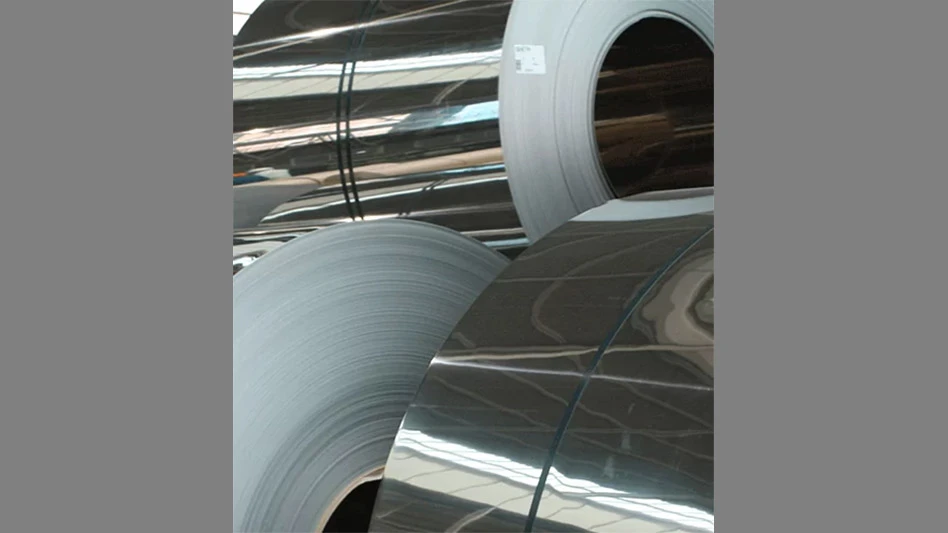 Moving into 2012, the copper market is giving no sign it will stabilize any time soon. Despite that, the pessimism that crept into the market throughout the fall of 2011 is giving way to a more upbeat outlook on the part of some observers.
Moving into 2012, the copper market is giving no sign it will stabilize any time soon. Despite that, the pessimism that crept into the market throughout the fall of 2011 is giving way to a more upbeat outlook on the part of some observers.
Several reports issued in late 2011 point to a moderate recovery in copper pricing, as many of the challenges that clouded markets during the first three quarters of the year are starting to clear. Some of the more bullish speculators point to the progress that is being made in resolving the sovereign debt problem, which has spread through much of Europe, for the improving outlook.
Several analysts also say they feel that copper has fallen into an over-sold situation—meaning the price has fallen too far, too fast to be sustainable—and a strengthening in price and demand could take place by the end of the first quarter of 2012. The reported declines in copper inventories at London Metal Exchange (LME) and Shanghai Futures Exchange warehouses also may help to keep copper prices from falling further.
Mixed Opinions
While several metals analysts are optimistic, it is far from a universal sentiment. Several copper scrap consumers still say they see significant challenges ahead. And, perhaps more problematic for this basic material, has been the failure of government and financial institutions to strongly address some of the fundamental problems that continue to plague the world economy.
One domestic copper scrap consumer says the metal is displaying significant volatility in terminal markets currently, with the trend toward the negative side. "It is putting pressure on margins and availability," he says. This environment, he adds, is making it far more difficult for his company to forecast very far into the future.
As a copper ingot maker, he says demand for his company's finished product is limited to domestic markets and the housing sector in particular. That reliance on the housing sector has been one of the big reasons for the less-than-robust recovery for the metal, he adds.
Tim Strelitz, president of California Metal-X, a Los Angeles-based brass and bronze ingot manufacturer, also is bearish. While optimistic about his company's future, he questions the validity of the global economic recovery. He says the quantitative easing approach (printing money, according to Strelitz) that Europe is taking will not likely be the cure for the continent's economic troubles. This approach, he claims, will keep the continent from seeing much in the way of economic recovery, muting any improvement in the copper market.
China's Influence
As for China, Strelitz says much of the copper that has been purchased during the past several years has gone toward speculative projects. This, he says, is something of growing concern for his company. Even as China continues to modernize its economy, Strelitz says he questions whether there is internal demand for many of these projects.
Adding to Strelitz' less-than-bullish outlook for China are recent statements by a Chinese minister that have helped to cast doubt on a strong rebound in the country early in 2012.
According to a report from Bloomberg News, during a recent metals conference, Wang Huajun, deputy secretary general of the China Nonferrous Metals Industry Association, said demand for copper, as well as for aluminum, could slow in 2012. "It is unlikely to see metals demand grow at more than 10 percent next year," Huajun reportedly said.
Customs data from China show that the imports of copper into China during the first 11 months of 2011 declined by nearly 10 percent.
In another Bloomberg News report, Wang Shouwen, head of China's foreign trade department within the Commerce Ministry, is quoted as saying that the country could face "severe" challenges in 2012.
Why is China such an integral component in the overall copper market? The most recent figures show that China consumes approximately 40 percent of all the world's refined copper.
While China's economic growth is slowing, it still outpaces economic growth in most other countries. The Organization for Economic Co-operation and Development (OECD) says China's economy will likely grow at a pace of approximately 8.5 percent in 2012. While still significant, especially in comparison with the U.S. and Western Europe, the OECD adds this would be the slowest growth the country has seen in 11 years.
More troublesome is that copper prices were softening toward the end of 2011, as the combination of a slowing Chinese economy and significant economic problems in Europe have resulted in sharply reduced demand and pricing for copper.
 With the continued uncertainty in the copper market, Strelitz is one of many who say a good approach is to keep a limited inventory of copper on hand.
With the continued uncertainty in the copper market, Strelitz is one of many who say a good approach is to keep a limited inventory of copper on hand.
Copper markets saw significant downward adjustments through most of 2011. After peaking in early 2011, copper prices began to decline, with the price declining by nearly 25 percent by the end of the year from its peak.
The continuing problems with the U.S. housing sector, which is a significant consumer of copper, also contribute to declining copper markets. Several sources say they do not expect to see a robust recovery in copper markets until there is more clarity within the U.S. housing sector.
Despite these challenges in the short term, the price of copper could be in a temporary trough and a recovery could take hold. According to a recent survey by Bloomberg News, for the first time since the fall of 2011, traders are expressing optimism about commodities markets, including copper.
A Glimmer of Hope
A key reason for the improved outlook for copper has been the sharp decline in copper inventories. Bloomberg News reports that Asian copper inventories as monitored by the LME have dropped by almost 70 percent since June 2011. Additionallly, the Shanghai Futures Exchange reports that copper inventories it tracks are at their lowest levels since July 2009.
Although Chinese government officials have been attempting to slow economic growth in the country, statistics show that imports of refined copper to China have picked up toward the end of 2011. Recent figures from the China General Administration of Customs shows that refined copper imports for November 2011 increased by nearly 50 percent compared with figures from the same period in 2010.
As gloomy as the U.S. housing market has been, there are some preliminary signs that it may have hit a bottom. A recent report from the U.S. Commerce Department shows that November 2011 new housing starts were the highest they have been in 18 months.
Another signal copper markets may find firmer footing in 2012 is the tighter supply being seen right now. Strikes at a number of copper mines have reduced the overall supply of copper.
One factor that may be playing a role in copper's strength in China has been the move by some to use the metal as collateral for loans. With Chinese banks tightening their lending practices, several sources have reported that companies are using copper as a form of collateral.
The most recent figures from the International Copper Study Group (ICSG) show a small production deficit of 13,000 metric tons of refined copper. However, when making seasonal adjustments for world refined copper production and usage, September showed a surplus of 18,000 metric tons. The apparent refined copper balance for the first nine months of 2011, including revisions to data previously presented, indicates a production deficit of 170,000 metric tons (a seasonally adjusted surplus of 33,000 metric tons). This compares with a production deficit of 429,000 metric tons (a seasonally adjusted deficit of 210,000 metric tons) through September 2010.
During the first nine months of 2011, world apparent copper usage grew by 1 percent compared with the same period in 2010. Although Chinese apparent usage grew by 9 percent in the third quarter of 2011, consumption in the through September was 0.5 percent less than the same time in 2010, as reflected by lower net imports in the first half of 2011.
In the European Union, Japan and the United States, usage weakened as the year progressed, with usage in the third quarter falling by 8.6 percent in the EU, 12 percent in Japan and 4.9 percent the United States compared with figures for the third quarter of 2010. In the first nine months of 2011, usage in these three regions declined by 0.5 percent, 3.8 percent and 0.3 percent, respectively. World usage without these four major users increased by 5 percent, primarily owing to a 72 percent increase in the Russian Federation and a 7 percent increase in India.
The author is senior editor of Recycling Today and can be contacted at dsandoval@gie.net.
Get curated news on YOUR industry.
Enter your email to receive our newsletters.

Explore the January 2012 Issue
Check out more from this issue and find your next story to read.
Latest from Recycling Today
- PureCycle makes progress on use of PureFive resin in film trials
- New copper alloy achieves unprecedented high-temperature performance
- Gränges boosts profits and sales volume in Q1 2025
- RMDAS April figures show recycled steel price setback
- Steer World offers PEX plastic recycling machine
- New recycling grant program launches in Massachusetts
- Tire Recycling Foundation names executive director
- Dock 7 named 2025 Exporter of the Year at New Jersey International Trade Awards







